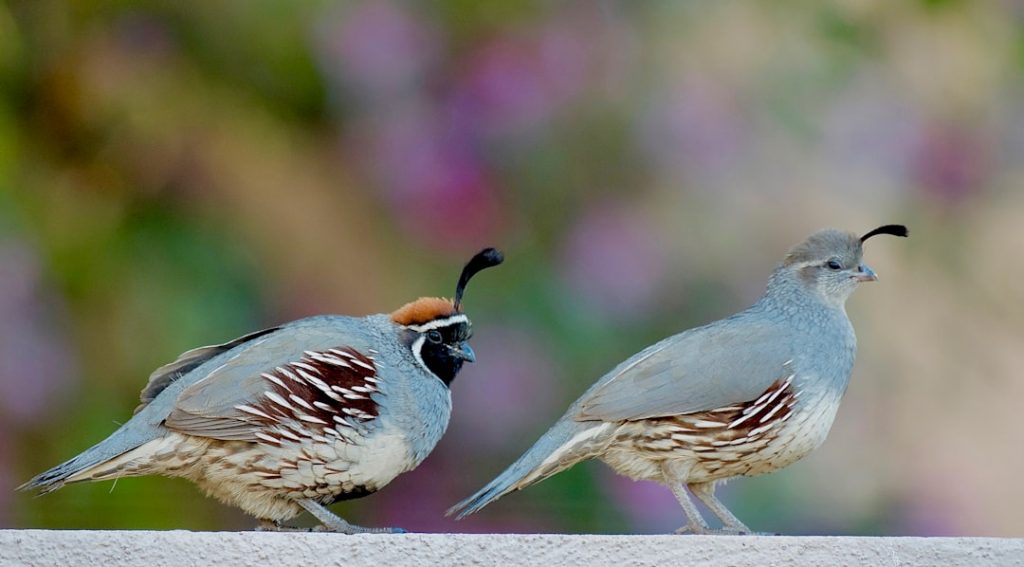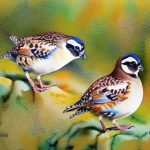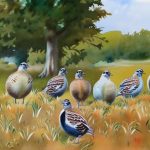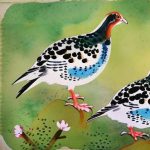Bobwhite quail breeding is a fascinating and rewarding endeavor for those interested in aviculture. The bobwhite quail, also known as the northern bobwhite, is a popular game bird native to North America. They are known for their distinctive call and are highly sought after for their delicious meat and beautiful plumage. Breeding bobwhite quail can be a profitable business, as there is a high demand for these birds in the hunting and culinary industries. Additionally, breeding bobwhite quail can also be a fulfilling hobby for bird enthusiasts who appreciate their beauty and unique behaviors.
Breeding bobwhite quail requires careful planning, attention to detail, and a deep understanding of the birds’ natural behaviors and needs. It is important to select the right breeding stock, provide a suitable breeding environment and housing, understand the birds’ mating behaviors, and properly care for the eggs and chicks. Additionally, maintaining the health and well-being of the breeding quail is crucial for successful breeding. In this comprehensive guide, we will explore the various aspects of bobwhite quail breeding, from selecting breeding stock to rearing chicks and managing health and disease. Whether you are a seasoned breeder or a beginner, this guide will provide valuable insights and practical tips for successful bobwhite quail breeding.
Table of Contents
- 1 Selecting Breeding Stock
- 2 Breeding Environment and Housing
- 3 Breeding Behavior and Mating
- 4 Incubation and Hatching
- 5 Rearing Chicks
- 6 Health and Disease Management in Breeding Quail
- 7 FAQs
- 7.1 What is bobwhite quail breeding?
- 7.2 What are the key considerations for bobwhite quail breeding?
- 7.3 What is the breeding season for bobwhite quail?
- 7.4 How do you select breeding stock for bobwhite quail?
- 7.5 What are some tips for successful bobwhite quail breeding?
- 7.6 How long does it take for bobwhite quail eggs to hatch?
- 7.7 What are some common challenges in bobwhite quail breeding?
Key Takeaways
- Bobwhite quail breeding requires careful selection of breeding stock to ensure healthy and productive offspring.
- The breeding environment and housing for bobwhite quail should provide adequate space, protection from predators, and proper ventilation.
- Understanding bobwhite quail breeding behavior and mating habits is essential for successful reproduction.
- Incubation and hatching of bobwhite quail eggs require consistent temperature and humidity levels.
- Proper rearing of bobwhite quail chicks involves providing a balanced diet, warmth, and protection from stressors.
Selecting Breeding Stock
Selecting the right breeding stock is crucial for successful bobwhite quail breeding. When choosing breeding stock, it is important to select birds that are healthy, genetically diverse, and have desirable traits such as good size, strong legs, and vibrant plumage. It is also important to select birds that have a good temperament and are not overly aggressive or skittish. Additionally, it is advisable to avoid inbreeding by selecting unrelated birds to prevent genetic abnormalities and health issues in the offspring.
When selecting breeding stock, it is recommended to choose birds from reputable breeders or suppliers who have a good track record of producing healthy and high-quality birds. It is also important to inspect the birds carefully for any signs of illness or deformities before making a purchase. It is advisable to start with a small number of breeding pairs to begin with, as this will allow you to focus on quality rather than quantity. By carefully selecting breeding stock, you can lay the foundation for a successful and sustainable bobwhite quail breeding program.
Breeding Environment and Housing
Creating a suitable breeding environment and providing proper housing for bobwhite quail is essential for successful breeding. Bobwhite quail are ground-dwelling birds that require a spacious and secure enclosure with access to natural vegetation, dust baths, and shelter. The breeding environment should mimic the birds’ natural habitat as closely as possible to ensure their physical and psychological well-being. The enclosure should be well-drained and free from drafts, with adequate protection from predators such as raccoons, snakes, and birds of prey.
The housing for bobwhite quail should provide ample space for the birds to move around freely and engage in natural behaviors such as foraging, dust bathing, and nesting. The enclosure should also include nesting boxes or shelters where the quail can lay their eggs and rear their chicks in privacy. It is important to provide clean bedding material such as straw or wood shavings in the nesting boxes to create a comfortable and hygienic environment for the birds. Additionally, the housing should be equipped with feeders and waterers that are easily accessible to the birds at all times. By providing a suitable breeding environment and housing, you can ensure the health and well-being of your bobwhite quail breeding stock and encourage successful breeding behavior.
Breeding Behavior and Mating
Understanding the natural breeding behavior and mating rituals of bobwhite quail is essential for successful breeding. Bobwhite quail are monogamous birds that form strong pair bonds during the breeding season. The males are known for their distinctive courtship displays, which involve puffing up their feathers, strutting, and calling out to attract a mate. Once a pair bond is formed, the male will continue to court the female by offering her food and performing elaborate displays to reinforce their bond.
During the breeding season, it is important to provide the breeding pairs with privacy and minimal disturbance to encourage natural mating behavior. The females will lay their eggs in the nesting boxes or shelters provided, and both parents will take turns incubating the eggs and caring for the chicks once they hatch. It is important to observe the breeding pairs closely for any signs of aggression or stress, as this can disrupt the mating process and affect the success of breeding. By understanding the natural breeding behavior and mating rituals of bobwhite quail, breeders can create an environment that encourages successful reproduction and ensures the well-being of the breeding pairs.
Incubation and Hatching
Incubation and hatching are critical stages in the bobwhite quail breeding process that require careful attention and proper management. Once the eggs are laid by the female, they should be collected promptly and placed in an incubator set at the appropriate temperature and humidity levels. It is important to handle the eggs gently and avoid any sudden movements that could damage the developing embryos. The eggs should be turned several times a day to ensure even heat distribution and proper development.
The incubation period for bobwhite quail eggs is approximately 23-24 days, during which time it is important to monitor the temperature and humidity levels closely to ensure optimal conditions for hatching. As the hatching date approaches, it is important to stop turning the eggs and increase the humidity levels to facilitate hatching. Once the chicks begin to hatch, they should be left undisturbed in the incubator until they are fully dry and active before being transferred to a brooder for rearing.
Proper incubation and hatching management are essential for ensuring high hatch rates and healthy chicks. By providing a controlled environment with optimal temperature and humidity levels, breeders can maximize the success of hatching and ensure the well-being of the newly hatched chicks.
Rearing Chicks

Rearing bobwhite quail chicks requires careful attention to their nutritional needs, environmental conditions, and social interactions. Once the chicks have hatched, they should be transferred to a brooder equipped with heat lamps, feeders, waterers, and clean bedding material. The brooder should be kept at an appropriate temperature (around 95-100°F) during the first week of life and gradually reduced as the chicks grow feathers and become more independent.
It is important to provide the chicks with a high-quality starter feed that is specifically formulated for game birds to ensure proper growth and development. Additionally, it is important to monitor the chicks closely for any signs of illness or weakness and provide prompt veterinary care if needed. Social interactions are also important for the chicks’ well-being, so it is advisable to raise them in groups to encourage natural behaviors such as feeding, grooming, and socializing.
As the chicks grow, they can be gradually transitioned to outdoor pens where they can acclimate to natural light, forage for insects and vegetation, and develop their natural instincts. By providing proper nutrition, environmental conditions, and social interactions, breeders can ensure the healthy growth and development of bobwhite quail chicks.
Health and Disease Management in Breeding Quail
Maintaining the health and well-being of breeding quail is essential for successful breeding and sustainable production. It is important to implement strict biosecurity measures to prevent the introduction of diseases into the breeding facility. This includes regular disinfection of equipment, quarantine procedures for new birds, and limiting access to outside visitors or animals that could potentially carry diseases.
Regular health checks should be conducted on breeding quail to monitor for any signs of illness or abnormalities. It is important to work with a qualified avian veterinarian who can provide guidance on disease prevention, vaccination protocols, and treatment options if needed. Additionally, it is important to provide a balanced diet with essential nutrients such as vitamins, minerals, and protein to support the birds’ immune system and overall health.
In conclusion, successful bobwhite quail breeding requires careful attention to every aspect of the breeding process, from selecting high-quality breeding stock to providing a suitable environment, understanding natural behaviors, managing incubation and hatching, rearing chicks, and maintaining health and disease management protocols. By following best practices in bobwhite quail breeding, breeders can ensure the well-being of their birds, maximize reproductive success, and contribute to the conservation of this iconic North American game bird species.
If you’re interested in learning more about bobwhite quail breeding, you may also want to check out this informative article on creating the perfect floor for your chicken coop at PoultryWizard. Understanding the importance of a suitable coop floor can provide valuable insights into creating a comfortable and healthy environment for your quails.
FAQs
What is bobwhite quail breeding?
Bobwhite quail breeding refers to the process of mating and raising bobwhite quail in captivity for the purpose of producing offspring with desirable traits.
What are the key considerations for bobwhite quail breeding?
Key considerations for bobwhite quail breeding include selecting healthy breeding stock, providing proper nutrition and housing, and managing breeding pairs to ensure successful reproduction.
What is the breeding season for bobwhite quail?
The breeding season for bobwhite quail typically occurs in the spring and summer months, with peak breeding activity occurring from April to July.
How do you select breeding stock for bobwhite quail?
When selecting breeding stock for bobwhite quail, it is important to choose birds that are healthy, free from genetic defects, and exhibit desirable traits such as strong fertility and good egg production.
What are some tips for successful bobwhite quail breeding?
Some tips for successful bobwhite quail breeding include providing a well-balanced diet, ensuring proper housing and nesting areas, and monitoring breeding pairs for signs of aggression or infertility.
How long does it take for bobwhite quail eggs to hatch?
Bobwhite quail eggs typically take 23-24 days to hatch after they have been laid. It is important to provide the eggs with proper incubation conditions during this time.
What are some common challenges in bobwhite quail breeding?
Common challenges in bobwhite quail breeding include low fertility rates, egg infertility, and issues with incubation and hatching. It is important to closely monitor breeding pairs and address any potential issues promptly.
Meet Walter, the feathered-friend fanatic of Florida! Nestled in the sunshine state, Walter struts through life with his feathered companions, clucking his way to happiness. With a coop that’s fancier than a five-star hotel, he’s the Don Juan of the chicken world. When he’s not teaching his hens to do the cha-cha, you’ll find him in a heated debate with his prized rooster, Sir Clucks-a-Lot. Walter’s poultry passion is no yolk; he’s the sunny-side-up guy you never knew you needed in your flock of friends!







